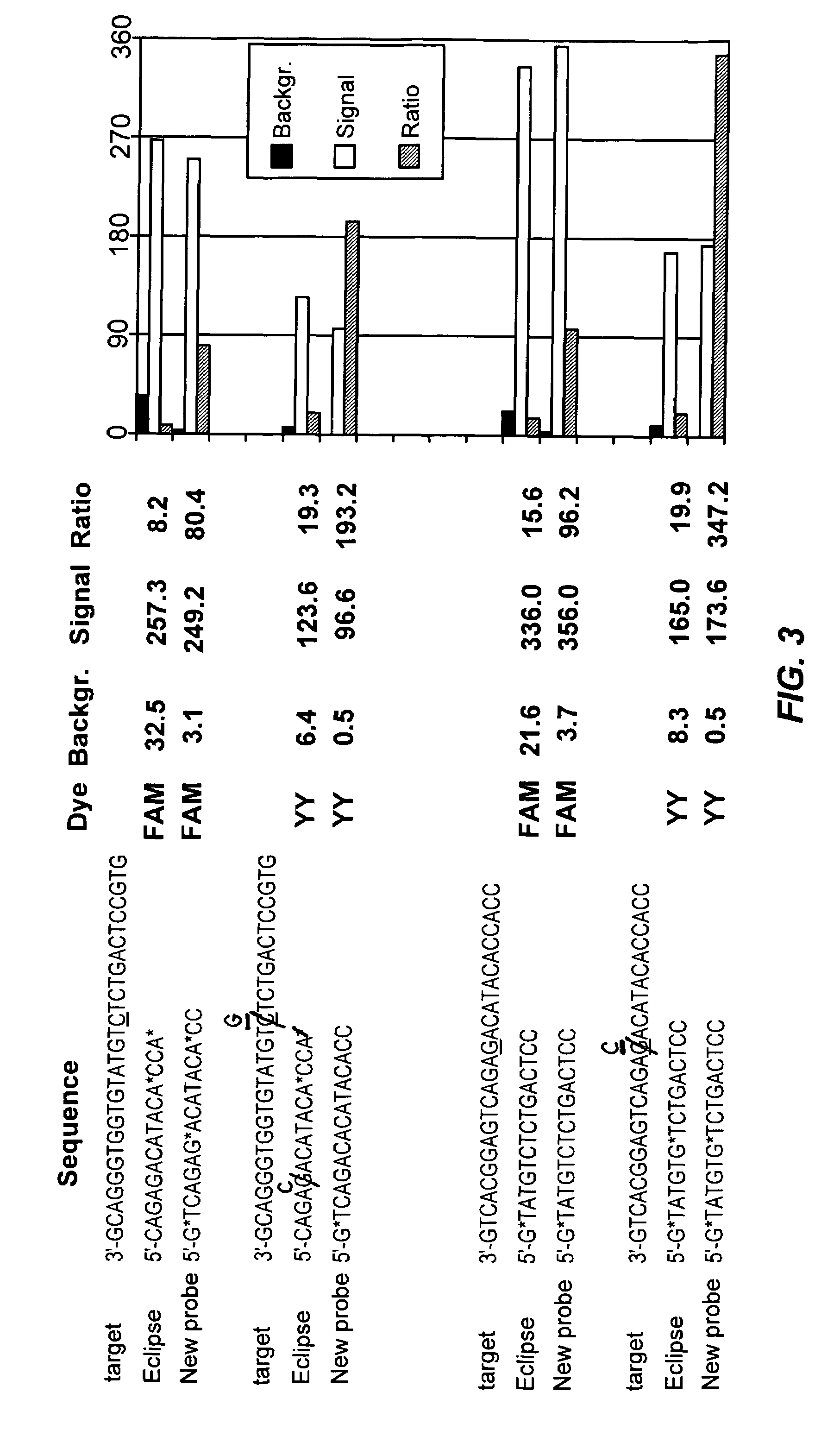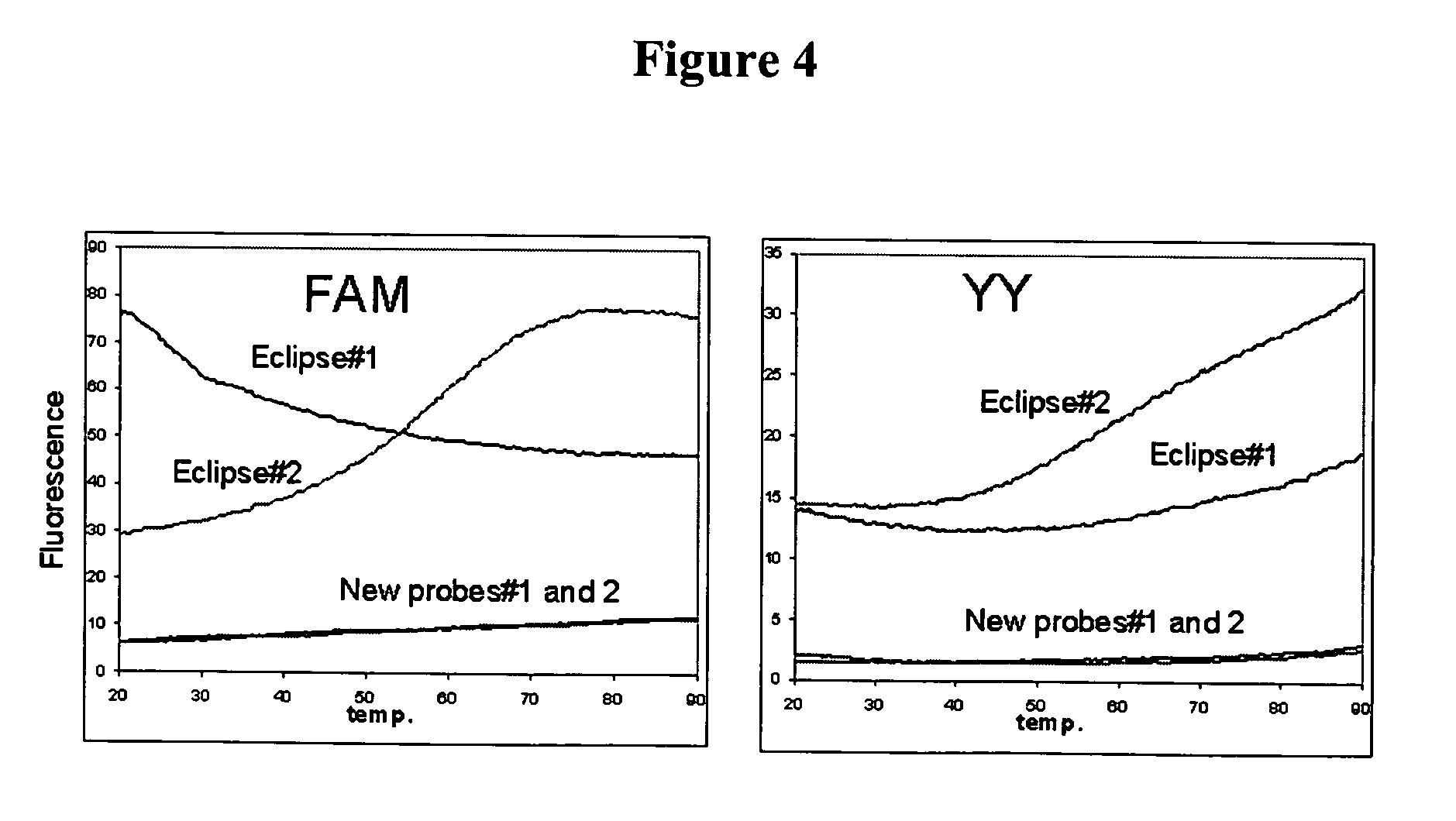Fluorescent probes containing 5'-minor groove binder, fluorophore and quenching moieties and methods of use thereof
a technology of fluorescence probes and binders, which is applied in the direction of sugar derivatives, biochemical instruments and processes, organic chemistry, etc., can solve the problems of unsuitable real-time amplification applications
- Summary
- Abstract
- Description
- Claims
- Application Information
AI Technical Summary
Benefits of technology
Problems solved by technology
Method used
Image
Examples
examples
Materials and Methods
[0178]Templates
[0179]One hundred and two unrelated Centre Etude Polymorphism Humaine (CEPH) DNA samples were obtained from the Coriell Institute of Medical Research (http: / / locus.umdnj.edu / ). A list of the templates used, is available at http: / / snp500cancer.nci.nih.gov.
[0180]Oligonucleotides
[0181]PCR primers were synthesized using standard phosphoramidite chemistry. The MB-FI-5′-ODN-Q probes were prepared by automated DNA synthesis on a minor groove binder modified polystyrene support (compound 20, Scheme 4) using 5′-β-cyanoethyl phosphoramidites (Glen Research, VA) designed for synthesis of oligonucleotide segments in 5′→3′ direction. Oligonucleotide synthesis was performed on an ABI 3900 synthesizer according to the protocol supplied by the manufacturer using a 0.02M iodine solution. Modified base phosphoramidites were synthesized based on methods previously disclosed (WO 03022859 and WO 0164958). The MGB ECLIPSE™ Probes were synthesized as described previousl...
example 5
[0203]This example illustrates the ability of the probe assay of the invention to genotype. One hundred and two unrelated Centre Etude Polymorphism Humaine (CEPH) DNA samples were genotyped for the presence of the ARNT-01 allele (G / C) by comparison with the MB Eclipse and probe of invention assays. The corresponding probes specific for each mismatch are shown in Table 2. Each sample was analyzed with the probes specific for wild-type and mutant target in a PCR assay described above. The PCR-end-point scatter plot genotyping analysis of the DNA samples is shown in FIG. 9. The scatter plot of the assay of the invention (FIG. 9a) correctly genotype all the DNA samples with clear separation between no template controls, wild-type, heterozygote and mutant DNA samples. In contrast, the MB Eclipse assay (FIG. 9b), the no-template control and heterozygote DNA samples are not clearly separated.
example 6
Hybridization Kinetic Comparison of Probes of the Invention and Molecular Beacons
[0204]This example shows that the probes of the invention hybridize significantly faster than molecular beacons to their respective targets. The hybridization kinetics of new probes and Molecular beacons were investigated with a rapid kinetics spectrophotometer accessory (Applied Photophysics, Surrey, UK) over a temperature range (30-55° C.). The probe and target concentrations were 1×10−7 and 2×10−7 M, respectively. The sequences of the probes and target are (SEQ ID NOS:26-28):
MB-FAM-gTCAGAgACATACaCC-Q (Probe of the invention),
FAM-CGGCGAGTCAGAGACATACACCAGCCG-Q (Molecular Beacon probe) and
GCAGGGTGGTGTATGTCTCTGACTCCGTG (Target Complement). The stem sequences are underlined and “a” and “g” are Super A and Super G, respectively.
[0205]
Probe ofMolecularinvention (P)Beacon (M)Reaction RateReaction Rate ConstantRatioTemp ° C.L * Mol−1 * sec−1L * Mol−1 * sec−1P / M300.41 × 1050.10 × 1054.05401.61 × 1050.27 × 1056...
PUM
| Property | Measurement | Unit |
|---|---|---|
| emission wavelengths | aaaaa | aaaaa |
| emission wavelength | aaaaa | aaaaa |
| Tm | aaaaa | aaaaa |
Abstract
Description
Claims
Application Information
 Login to View More
Login to View More - R&D
- Intellectual Property
- Life Sciences
- Materials
- Tech Scout
- Unparalleled Data Quality
- Higher Quality Content
- 60% Fewer Hallucinations
Browse by: Latest US Patents, China's latest patents, Technical Efficacy Thesaurus, Application Domain, Technology Topic, Popular Technical Reports.
© 2025 PatSnap. All rights reserved.Legal|Privacy policy|Modern Slavery Act Transparency Statement|Sitemap|About US| Contact US: help@patsnap.com



